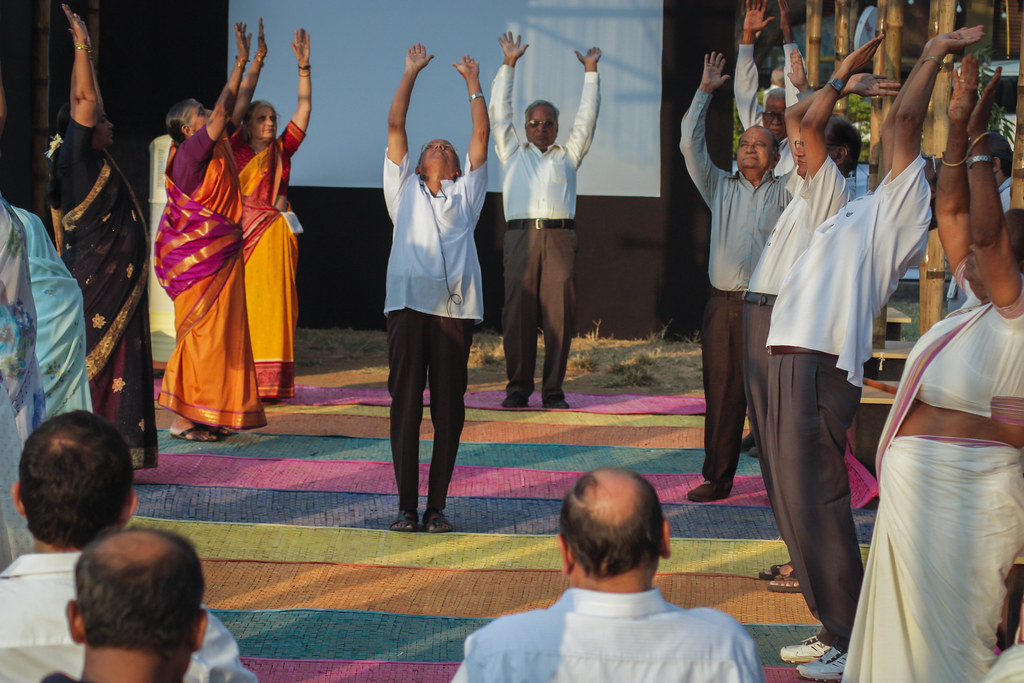In the quest for better health and well-being, a unique practice has gained attention for its ability to promote both physical and emotional healing: Laughter Yoga. At first glance, it may seem unconventional, but this practice has been growing in popularity as a powerful tool for stress relief and overall health enhancement. But what exactly is Laughter Yoga, and what makes it beneficial? In this article, we’ll explore the origins, methods, and health benefits of Laughter Yoga, delving into how it works and why it’s catching on as a joyful approach to wellness.
What is Laughter Yoga?
Laughter Yoga is a unique exercise routine that combines voluntary laughter with yogic breathing techniques (known as pranayama). It was developed in 1995 by Dr. Madan Kataria, a physician from India, who sought to find a way to promote the health benefits of laughter. What sets Laughter Yoga apart from traditional yoga is that it does not rely on humor, jokes, or comedy to stimulate laughter. Instead, the laughter in Laughter Yoga is simulated through group exercises but quickly turns into genuine laughter due to the contagious nature of laughter itself.
The core premise of Laughter Yoga is that the body cannot distinguish between fake and real laughter. Both types of laughter bring about similar physiological and psychological benefits. Participants gather in groups, often in open spaces like parks, and engage in playful exercises that encourage them to laugh intentionally, such as role-playing, clapping rhythms, or chanting “Ho ho ha ha ha” while maintaining eye contact with others. This encourages spontaneous laughter to follow, leading to a cascade of health benefits.
The practice incorporates simple yoga breathing techniques, which help oxygenate the body and mind, leaving participants feeling more energized and relaxed. Sessions usually last between 30 to 60 minutes and are often led by certified Laughter Yoga leaders. Though the practice is simple and playful, it is based on the science of laughter and its profound effects on mental and physical health.
The Science Behind Laughter Yoga
At the heart of Laughter Yoga is the understanding that laughter triggers physiological changes in the body that can enhance both mental and physical health. Laughter, whether real or simulated, stimulates the release of endorphins, the body’s natural feel-good chemicals. These endorphins promote an overall sense of well-being and can temporarily relieve pain. At the same time, laughter reduces the levels of stress hormones like cortisol and adrenaline, making it an effective stress management tool.
The deep belly laughs encouraged in Laughter Yoga also engage the diaphragm and stimulate the parasympathetic nervous system, which is responsible for the body’s relaxation response. This deep diaphragmatic breathing not only brings more oxygen into the body and brain, but it also promotes circulation, leading to lower blood pressure and improved heart function.
Several studies have looked into the effects of laughter on health. Research shows that laughter can help boost the immune system by increasing the production of antibodies and activating T-cells, which play a critical role in fighting off infections. Laughter has also been linked to improved mood, helping to alleviate symptoms of depression and anxiety by promoting a more positive outlook on life. In this way, Laughter Yoga combines both the physiological benefits of laughter and the psychological benefits of being part of a supportive, social environment.
What Is Laughter Yoga Good For?
Laughter Yoga offers a wide range of health benefits, from reducing stress to improving heart health. Below are some of the most notable benefits that have made it popular around the world.
1. Stress Relief and Relaxation
One of the primary benefits of Laughter Yoga is its ability to reduce stress. In today’s fast-paced world, stress is an inevitable part of life, but it’s also a significant contributor to a variety of health issues, including heart disease, high blood pressure, and mental health disorders. Laughter Yoga encourages a release of tension through laughter, which reduces cortisol levels and activates the body’s natural relaxation response. The deep breathing involved helps calm the mind, creating a sense of inner peace and relaxation.
Moreover, because laughter is a natural stress reliever, it allows participants to momentarily escape from their worries, giving the mind and body a break from the pressures of daily life. Many people report feeling more refreshed, centered, and capable of handling life’s challenges after a Laughter Yoga session.
2. Improved Mood and Mental Health
Laughter Yoga is particularly good for improving mental health. By triggering the release of endorphins, it enhances mood and creates an overall sense of well-being. This “natural high” helps reduce symptoms of depression and anxiety, especially in people who may feel isolated or overwhelmed. The practice also increases dopamine, a neurotransmitter that plays a role in mood regulation and the reward system, making you feel happier and more optimistic.
Additionally, the social aspect of Laughter Yoga—practicing in a group and making eye contact with others—fosters a sense of connection and community. This is especially beneficial for individuals dealing with loneliness or depression, as it provides a safe and supportive space to interact and share positive emotions. Laughter Yoga has also been used as a therapeutic tool in clinical settings to help patients dealing with mental health disorders, grief, or trauma.
3. Cardiovascular Health and Fitness
Laughter Yoga offers a light cardiovascular workout, making it good for heart health. The sustained laughter during a session raises the heart rate, similar to light aerobic exercise, which can improve blood circulation and oxygen intake. Studies have shown that laughing for 10-15 minutes a day can improve cardiovascular function by increasing vascular flow and reducing arterial stiffness.
The deep breathing exercises in Laughter Yoga also play a role in improving lung capacity and increasing oxygen flow to the heart and muscles. This oxygenation is crucial for maintaining heart health and reducing the risk of heart disease. For those who may find traditional forms of exercise difficult due to age or physical limitations, Laughter Yoga provides a low-impact alternative that still delivers cardiovascular benefits.
4. Boosted Immune System
The positive impact of laughter on the immune system is another significant benefit of Laughter Yoga. Laughter stimulates the production of natural killer cells and antibodies that fight off infections and disease. It enhances the body’s immune response by increasing the activity of T-cells, which are critical for immune defense.
For individuals who frequently fall ill or feel run down, Laughter Yoga can serve as an immunity booster, helping the body better resist infections and recover more quickly from illness. The regular practice of laughter can also help reduce inflammation, which plays a role in many chronic diseases, including autoimmune disorders.
5. Enhanced Creativity and Cognitive Function
Another lesser-known benefit of Laughter Yoga is its impact on creativity and cognitive function. Laughter stimulates both hemispheres of the brain, promoting a balance between logical and creative thinking. This can help improve problem-solving abilities and enhance mental clarity. By fostering a positive and relaxed mental state, Laughter Yoga allows individuals to approach challenges with an open and flexible mindset, leading to more innovative solutions.
This benefit can be particularly useful in the workplace or creative fields where out-of-the-box thinking is required. Regular participation in Laughter Yoga can help break mental blocks and boost productivity by reducing mental fatigue and enhancing overall brain function.
6. Pain Relief
Laughter Yoga has been found to act as a natural pain reliever. Endorphins, which are released during laughter, act as the body’s natural painkillers. These feel-good chemicals help to reduce the perception of pain and can provide temporary relief from conditions such as chronic pain, arthritis, and fibromyalgia. In fact, many pain management programs have incorporated Laughter Yoga as a complementary therapy to help patients cope with their symptoms.
Furthermore, the deep relaxation that follows a Laughter Yoga session can alleviate tension in the body, helping reduce muscle stiffness and soreness. For those dealing with chronic pain, practicing Laughter Yoga regularly can provide both physical relief and emotional support.
How to Practice Laughter Yoga
Laughter Yoga can be practiced in a variety of settings, including Laughter Yoga clubs, wellness centers, or even at home. A typical session begins with a warm-up that involves stretching, clapping, and rhythmic chanting to get participants comfortable and prepared for laughter. The leader then guides the group through a series of laughter exercises, which may involve role-playing, making playful sounds, or pretending to laugh while maintaining eye contact with others.
In between the laughter exercises, participants take short breaks for deep breathing, allowing the body to relax and recover before moving on to the next round of laughter. The session typically ends with a short meditation or a relaxation period, giving participants time to absorb the effects of the practice and leave feeling refreshed and rejuvenated.
If you can’t attend a Laughter Yoga class, you can still practice it on your own by watching online videos or following guided exercises at home. The key is to allow yourself to laugh freely, without worrying about how “real” the laughter feels at first—genuine laughter often follows as you relax into the exercise.
Conclusion
Laughter Yoga is a joyful and effective way to enhance both mental and physical well-being. By combining the simple act of laughing with breathing exercises, it offers a unique approach to reducing stress, improving mood, and boosting cardiovascular and immune health. While it may seem unconventional at first, the practice taps into the deep, natural healing power of laughter, making it accessible to people of all ages and fitness levels. Whether you’re looking for a way to manage stress, connect with others, or simply improve your overall health, Laughter Yoga provides a fun and transformative experience that supports a healthier, happier life.




